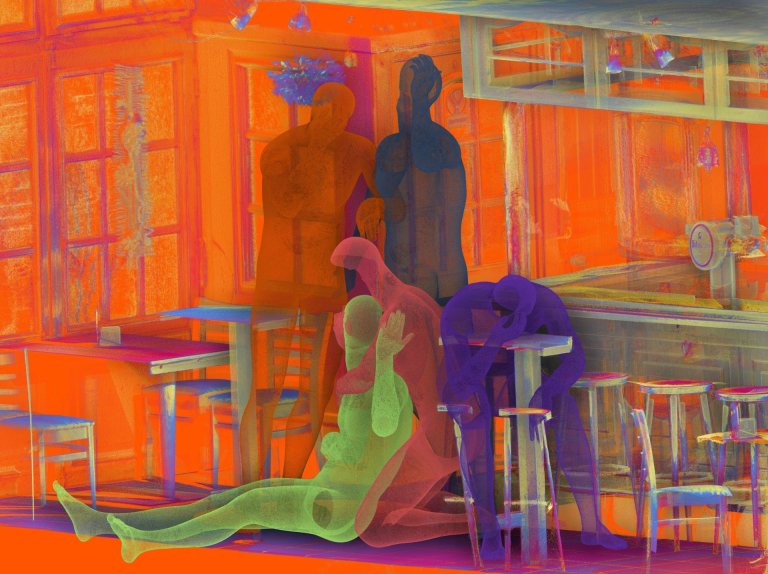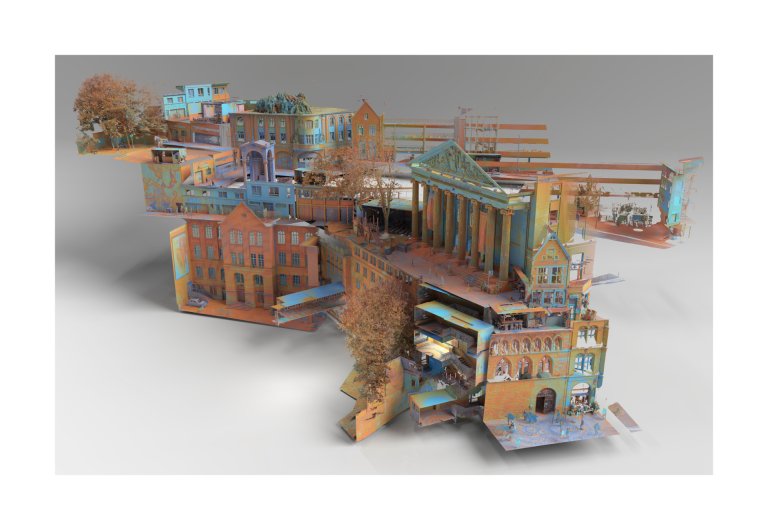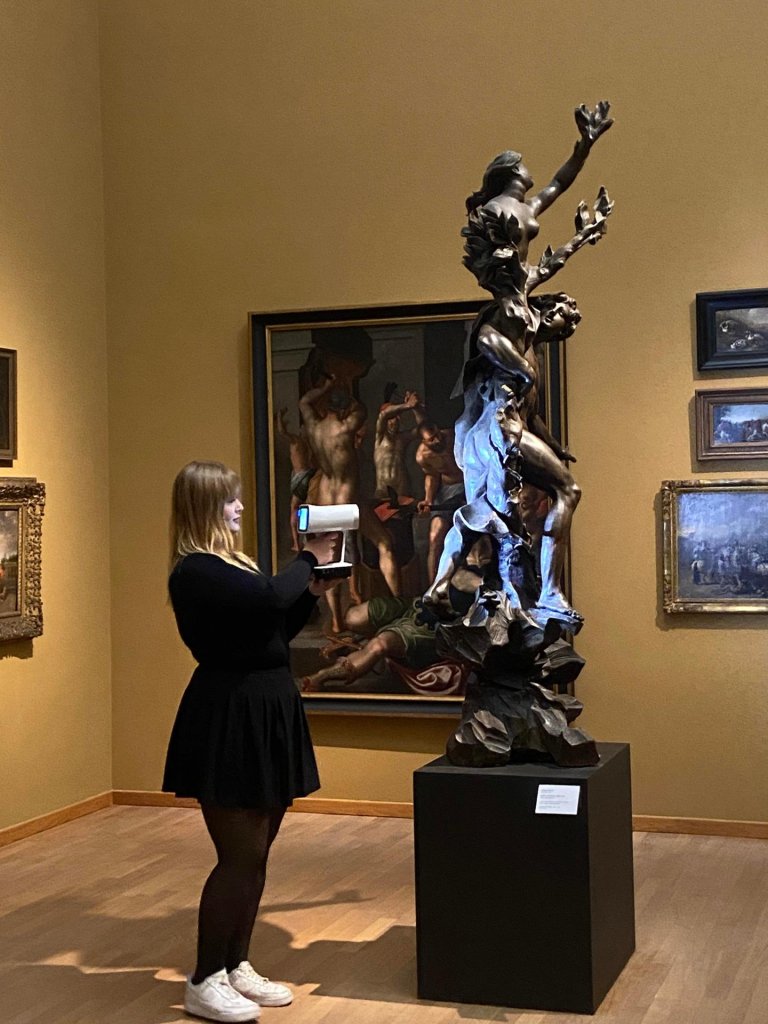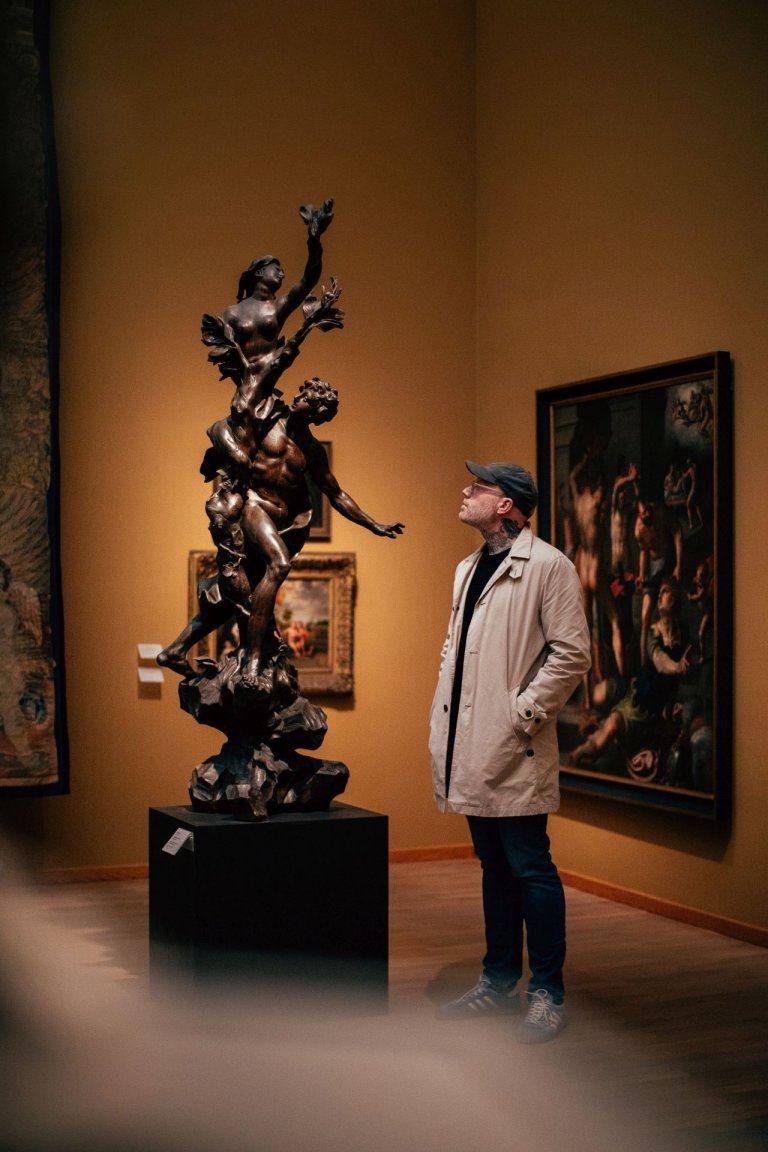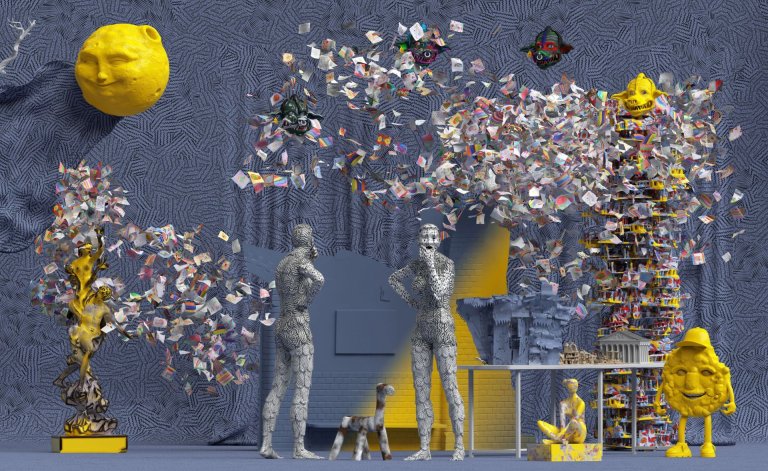New exhibition at the Suermondt-Ludwig-Museum Aachen
Tim Berresheim.
Place. Time. Continuum.
25.06.2025 - 01.02.2026
www.suermondt-ludwig-museum.de
The installation "Place. Time. Continuum"
"Place. Time. Continuum." This is the name of Tim Berresheim's first monumental 360°-degree mural, which he created especially for the Suermondt-Ludwig-Museum and which can be seen here until February 1, 2026.
Viewed through 3D glasses, a vivid panorama of Aachen's city history unfolds, peppered with allusions to art history and personal matters. You can see the cathedral, the Grashaus, the antique façade of the theater. Michelangelo's divine hint from the story of creation in the Sistine Chapel, which brings the expectant Adam to life, is interpreted as the fall from hell: The hand of God meets a fallen angel here. Fittingly, it is tattooed with evil.
An outstanding motif of the mural is the mythological sculpture 'Apollo and Daphne' by the Italian sculptor Filippo Parodi (1630-1702), a work from the collection of the Suermondt-Ludwig-Museum. The sculpture is a so-called figura serpentinata, a sculpture around which viewers can walk and thus grasp the work of art in its entirety. Sculptors since the Renaissance wanted to demonstrate their superiority over two-dimensional painting with this "all-pervasiveness". Berresheim's immersive sculpture combines the advantages of sculpture and painting: although it appears "flat" at first glance, you can walk around it completely when viewed through 3D glasses.
The digital data for the motif comes from students at the College vhs Aachen. They chose the sculpture as the starting point for their creative work as part of the project "New strength from old roots" (see below for more information) and scanned it in the course of their work.
In addition to the scan of the sculpture, other results of the "New strength from old roots" project have also been incorporated into the mural, for example countless sheets of paper with drawings by children from the elementary school at Fischmarkt, which flutter through the scenery in clusters. The drawings are an expression of the children's engagement with the urban environment in which they spend time every day. In the course of this, the cartoon character Bibbes, the crumble roll, also developed, a testimony to Aachen's culinary tradition.
Regular guest of the Steffens-Schänke
Two independent pictures are integrated into the wall piece. One shows the interior of the Steffens-Schänke, an Aachen pub on the square of the same name, which no longer exists today. Apparently to the regret of the artist, who has integrated himself into the picture several times as a set of data that has become a body and thus remains a regular even after the pub has disappeared.
"Luogo o spazio?" shows relics of architectural models from Aachen's building history, stacked in a deconstructivist manner and in rusty, stained colors. A dystopian-looking landscape of ruins as a vanitas image, reminiscent of transience and thus devoid of the lovely effect of baroque ideal landscapes with the remains of columns and other set pieces from antiquity, in whose tradition this work stands.
History - a constant metamorphosis
Tim Berresheim's installation is a meandering walk through history. Like an archaeologist, he digs through layers of history, collects finds, maps them, reassembles them, contextualizes them and tells his own story. In doing so, he shows en passant what history is: a constant metamorphosis, a huge amount of diverse data in time and space, the narration of which is a question of the authority of interpretation. And that even as a schoolchild you can conquer a part of this sovereignty of interpretation: with your own commentary on your own discovery - and with the artistic means of your choice.
It is no coincidence that all possible forms of artistic expression, materials and digital data are interwoven in the installation and equally validly assembled in the pictorial space: Architectural model, children's drawings, tattoos, small sculptures, large sculptures, comic figures, cloth and wallpaper, paper and papier-mâché, haptic and immaterial. Here, a sculpture is no more important than a tattoo. Here, a precious wood is no more valuable than papier-mâché.
Metamorphosis everywhere. Only a small axolotl defies the seemingly inevitable course of history. This strange creature from the underworld is one of the few amphibians that does not undergo metamorphosis and spends its entire life as a gill-breather in the water. So much stubbornness is a must.
This is the second exhibition at the Suermondt-Ludwig-Museum in which contemporary artists enter into a direct dialog with the collection. As with the 2024 show by Düsseldorf painter Volker Hermes, who responded to portraits in the collection with his works, the museum also wants to link the familiar with the unknown with Tim Berresheim's works and thus enable visitors to have substantially new visual and artistic experiences that exceed their respective expectations and knowledge horizons and remind them of the museum as a constantly up-to-date place of experience and learning.
Curator:
Sarvenaz Ayooghi
Wall texts in the exhibition:
Genesis
Tim Berresheim (*1975) lives and works in Aachen. He has been a pioneer of computer-aided visual art for over 20 years. In the wall piece created especially for this room, he uses materials that were created as part of his project "New strength from old roots".
The story of creation is given a special role, represented here by Adam. Berresheim makes the connection to art history clear by drawing on one of the most famous motifs in art: Michelangelo's "Creation of Adam". The ceiling fresco in the Sistine Chapel shows scenes from the story of creation from the Book of Genesis. By inserting his scanned arm with the outstretched index finger and the familiar gap, Berresheim breathes life into his digital work.
Metamorphosis
A central theme is metamorphosis (transformation), symbolized by the sculpture 'Apollo and Daphne' from the collection of the Suermondt-Ludwig-Museum. The emotionally charged scene from Ovid's Metamorphoses shows how Daphne("laurel" in Greek) transforms into a laurel tree in order to escape from the clutches of the amorous Apollo, who was previously struck by Cupid's arrow. This drama deeply moved the students of the College vhs Aachen, who were involved in the creation process. Berresheim digitally implements their input here and restages the sculpture, both in the mural and in an augmented reality (via QR code on the base of the sculpture). Berresheim directs the framework conditions of the mural, determining and changing them according to his own ideas.
Vanitas
Tim Berresheim's love for his home town of Aachen motivated him to survey places, locations and streets that are important to him and some of which no longer exist.
His favorite pub, the 'Steffens-Schänke', for example, is one such place that has not survived the consequences of the coronavirus pandemic. Berresheim has scanned the pub on Steffensplatz as well as his own body so that he can virtually 'clean up' there. Büchel and Antoniusstraße, which had to shut down during the pandemic, are also part of his data collection.
Vanitas (transience) is shown in this fragility of the analog in comparison to the digital and makes the interfaces between the worlds visible.
The "New strength from old roots" project
Since the end of 2023, artist Tim Berresheim has been involved in the large-scale digital art and participation project "Aus alter Wurzel neue Kraft" on behalf of the city of Aachen, in which Aachen schoolchildren of different ages and school types have been significantly involved. The title goes back to the motto of Christian shooting fraternities at the beginning of the 20th century.
This participatory project in the best sense of the word is based on a process of appropriation carried out by the participants under the guidance of the artist, which consisted of numerous workshops in the Am Fischmarkt elementary school, the Kaiser-Karls-Gymnasium and the College vhs Aachen as well as at selected locations in the city. The results of the work were repeatedly presented to the public.
Right from the start, the Suermondt-Ludwig-Museum sought a dialog with the artist in order to open up its collection to the participants - another component of the museum's work, which is currently strongly oriented towards cultural participation. After a comprehensive introduction by the museum's own curators, the College vhs Aachen participants worked with exhibits from the collection in workshops and then chose the large-format mythological sculpture 'Apollo and Daphne' by the Italian sculptor Filippo Parodi (1630-1702) as the starting point for their creative experiments and thought processes. The College vhs project will be presented alongside the Berresheim exhibition, including through an app designed by the artist.
Project management:
Myriam Kroll
The artist
Tim Berresheim, *1975, is an internationally active, multimedia visual artist and pioneer of computer-aided art. He creates complex visual worlds that develop from the tension between computer technology and the questioning of his own reality. His works include 2D and
3D prints, photographic prints and sculptures, augmented reality sculptures and videos as well as various art-in-architecture projects. Berresheim strives to reflect the complexity of our time in his works and to present viewers with new challenges in the reception of images, creating intense worlds of experience at the interface of art/research/technology.
Berresheim studied with Albert Oehlen at the Kunstakademie Düsseldorf and with Johannes Brus at the HBK Braunschweig.
You can subscribe to our RSS feed for our press releases here https://www.aachen.de/rss-feed-pressemitteilungen/rss.xml
